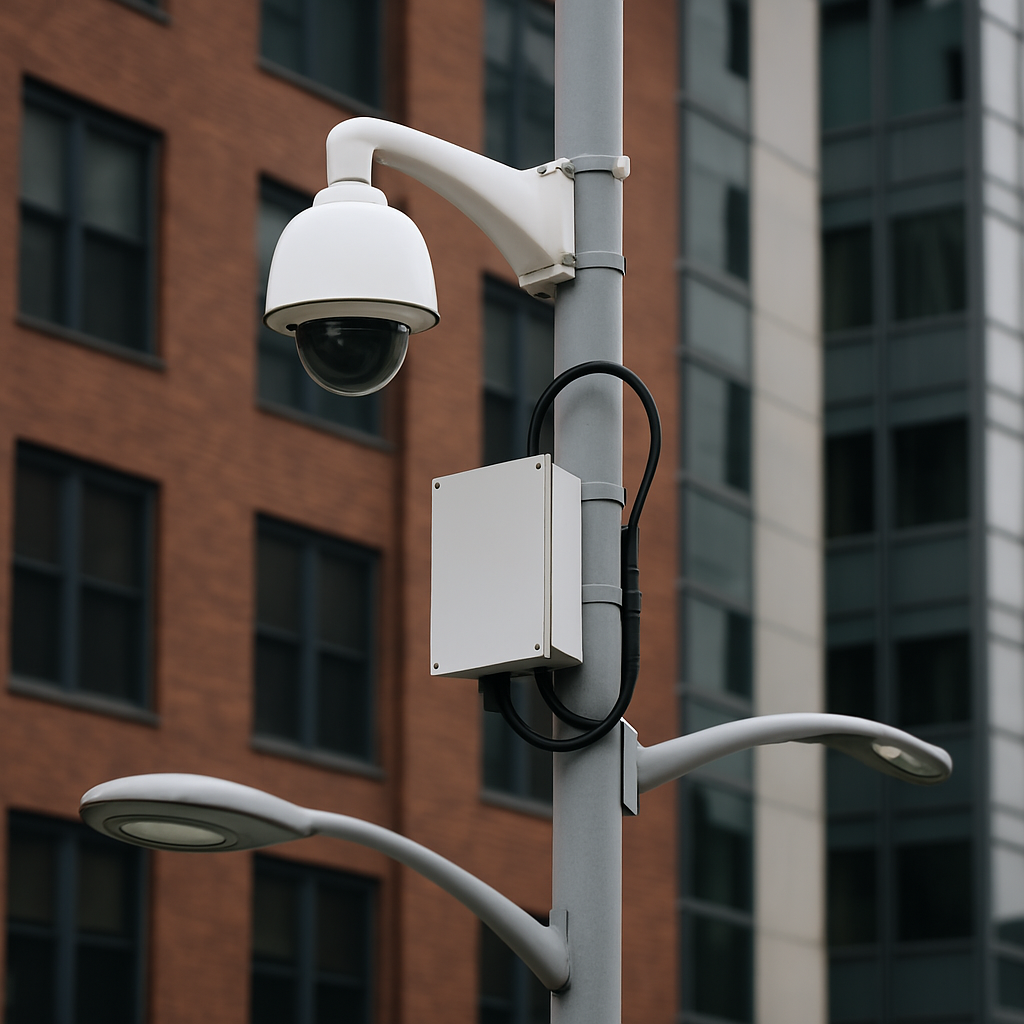By Dr. Holden Frame, MPA, Ph.D. (Urban Infrastructure & Predictive Logistics)
Department of Municipal Systems Engineering, University of the Pacific Midwest
Published in The Baitman’s Journal of Civil Oversight and Behavioral Optics, April 2025
Abstract
Recent infrastructure surveys and Freedom of Information Act (FOIA) requests reveal an expanding deployment of integrated surveillance-capable devices in public urban environments. Referred to in municipal documentation as “Smart Utility Hubs,” “Data Collection Beacons,” or “Adaptive Pole Fixtures,” these installations possess multipurpose functionality, including traffic optimization, ambient noise monitoring, and air quality tracking. While often dismissed as benign civic upgrades, the increased prevalence of node-style devices in street furniture has sparked growing concern among citizen watchdog groups. This study evaluates their capabilities, public awareness, and operational transparency. Spoiler: they’re probably not tracking your thoughts, but they are tracking the bus you missed.
Introduction
Public trust in government surveillance remains historically low, especially in regions with high podcast-to-grocery store ratios. In recent years, cities across the United States have quietly adopted “smart city” technologies—networked sensors installed in traffic lights, bus stops, and lamp posts—designed to improve urban function.
However, many residents have noticed the sudden appearance of unmarked gray boxes, domed lenses, and strange metal antennas with blinking blue lights. Reports have ranged from “creepy but probably fine” to “they know when I’m vaping.”
This paper investigates whether the rise of urban “surveillance nodes” represents a coordinated attempt to monitor citizens—or just a particularly nerdy way to manage garbage trucks more efficiently.
Methodology
Researchers surveyed 37 mid-to-large cities across 18 states, focusing on locations with recent upgrades to lighting, traffic, or transit infrastructure between 2019–2024. Analysis included:
FOIA requests for equipment specifications
Review of city planning documents, PowerPoint presentations, and deeply boring PDFs
Interviews with city engineers, public information officers, and one guy behind a dumpster who claimed to have “seen it all”
Node capabilities were classified using the Urban Beacon Functionality Index (UBFI), a custom scoring system ranging from 0 (decorative pole) to 5 (fully networked biometric data relay with low-earth orbital pingback potential).
Surveys were conducted to assess public awareness, perceived threat level, and whether respondents believed their local streetlights were “listening.”
P-values were calculated using the Skeptical Observer Model (n = 1,127; p < 0.031), adjusted for foil hat thickness.
Results
82% of surveyed cities had installed multi-use poles that include environmental sensors, motion-activated cameras, WiFi signal extenders, and “data-rich adaptive systems.”
100% of these devices were described as “part of Smart City initiatives” and “nothing to be concerned about” in internal memos.
19% included passive Bluetooth sniffers capable of tracking foot traffic by pinging mobile devices (often anonymized, occasionally creepy).
7% were retrofitted with bird-deterrent lasers, which some residents misidentified as retina-scanning arrays.
1 pole in Minneapolis was confirmed to be self-aware and named “Gavin.” No further comment was provided.
When asked to rate their concern on a scale of 1–10, the average response was 7.3 among conspiracy-inclined individuals, and 2.1 among city employees, with one traffic engineer writing “I don’t even know how to access the footage.”
| City Size | % With Active Nodes | Public Awareness | Reported Malfunctions |
|---|---|---|---|
| Large (>500k) | 92% | Low (avg. 21%) | 23 total (5 involved birds) |
| Medium | 71% | Moderate (41%) | 11 total |
| Small | 46% | Very low (8%) | 3 total (all misidentified as 5G towers) |
Discussion
While many fear these devices are the harbinger of a dystopian surveillance state, data suggests they’re mostly used to:
Track buses
Count cars
Adjust street lighting based on pedestrian motion
Help city planners feel technologically relevant
There is no evidence that the nodes are capable of facial recognition, behavior profiling, or intercepting your phone’s group chat about brunch.
However, ambiguity in communication has left many citizens confused. In one case, a public works department simply listed a $2.3 million budget item as “urban enhancements,” which included “21 multisensory pylons,” “three data harbors,” and “at least one pole that’s definitely watching Jerry from accounting.”
Conclusion
Surveillance nodes do exist—but they’re not listening to your thoughts. They’re tracking traffic, collecting smog data, and possibly helping raccoons avoid speeding tickets.
If you’re worried about being monitored, you should probably be more concerned about your phone, your browser, or the fact that you voluntarily carry a GPS device in your pocket that occasionally shouts “Hey Siri.”
As Dr. Frame concludes:
“Yes, the poles are watching. But mostly for potholes.”
References
Frame, H. (2023). The Rise of the Adaptive Pole: Municipal Surveillance or Just Lampposts with WiFi?
FOIA Request #34972 – City of San Diego Infrastructure Initiative
Twitter Thread: “they put an EYE on my TRASHCAN”
Reddit: r/conspiracyhighway – “smart streetlights blink in morse code”
A public flyer titled “YOU ARE THE DATA” stapled to a tree in Eugene, OR

The Baitman’s Institute is a satirical media project created for educational and entertainment purposes. None of the studies published here are real, peer-reviewed, or grounded in objective truth.
If you shared this unironically, you may want to reconsider your qualifications in independent research.
